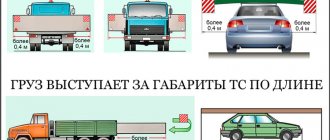Is it possible to transport
Transportation of gas containers by car is not prohibited by the rules. They need to be transported somehow. Whether it is possible to transport a gas cylinder in a car and how it is done correctly is described in ADR - the International Agreement on the Road Transport of Dangerous Goods and the "Rules for the Transportation of Dangerous Goods by Road", introduced by the Ministry of Transport in 1999.
In addition to the list of substances classified as hazardous, the rules also indicate the maximum permissible volumes. Having understood the nuances, it is easy to understand whether it is possible to transport a gas cylinder in the trunk of a car. Of course, this is permissible, but subject to a number of conditions.
The traffic rules state that the transportation of containers with gases must be carried out in accordance with accepted rules. And the Code of the Russian Federation on Administrative Violations provides for liability for their violation.
And one more important point is the technical condition and pressure testing of the cylinders themselves. For example, for HBO, once every 2 years it is necessary to undergo an examination procedure.
Other liquids
Please note that there are no separate requirements or restrictions for the carriage of personal use and other types of liquids that are dangerous goods, including:
- paints and solvents,
- glue,
- acetone,
- biodiesel,
- ethanol,
- acids and alkalis,
- perfume liquids,
- ethers,
- liquid pesticides or nitrates.
The ADR rules continue to apply here: no more than 240 liters per car and no more than 60 liters of containers for packaging them. The purpose of transportation must be either personal needs or retail sales.
Transportation rules
The rules for transporting gas cylinders by road do not apply to a limited number of containers in one vehicle. Containers containing gaseous substances may only be transported in a horizontal position. The gas containers themselves must have inscriptions with the name of the substance. Their maximum number is determined in the European Agreement concerning the International Carriage of Dangerous Goods by Road (ADR) in section 1.1.3.
Formally, the transportation of gas cylinders by road is not prohibited for private individuals if the containers are well-packed and all measures are taken to prevent leakage.
All gaseous substances are divided into categories. Not all gases are recognized as hazardous for transportation.
Gaseous substances belonging to different categories are prohibited from being transported in the same vehicle.
Having carefully studied the rules for transporting gas cylinders in a passenger car, we conclude that transportation is allowed:
- Up to five 50-liter pressure tanks with oxygen, argon, carbon dioxide, acetylene and propane, subject to specially equipped space. They should be in a container or on a wooden comb.
- More than 5 units, if the car is equipped for transporting goods recognized as dangerous, and the driver has undergone appropriate training and received a certificate.
Transportation of gas cylinders by road transport in the cabin is strictly prohibited. You can transport them in the trunk, subject to safety standards.
Smoking during transportation is prohibited. Brake sharply and stop near open flames too.
The vehicle must not be left unattended, and if there are signs of leakage, gas containers must be removed at least 100 meters from residential buildings.
Transporting propane in cylinders by road is associated with great risk. They should not be loaded with the valves facing down or while wearing dirty gloves. Propane and oxygen cannot be transported at the same time. It is absolutely necessary to prevent overheating above 45 degrees. Containers must be secured to a solid base, otherwise an explosion may occur.
It is important to note: if there are more than three containers, then traffic police officers may require receipts confirming the fact of purchase. As a piece of advice, we note that the best option for transportation is 2 cylinders.
Number of oxygen cylinders that can be transported without ADR
An unlimited number of oxygen cylinders are allowed, which are transported without ADR. However, traffic police officers will pay attention to vehicles if the number of cylinders in it exceeds 15 pieces. Then employees can request permission from the driver.
How should gas cylinders be delivered:
- Transport must be specially equipped.
- The cylinders themselves must be in good condition.
- Transportation of gas cylinders is carried out in special containers with safety equipment.
- The cylinders have identification marks and inscriptions of different colors established in GOST.
- Do not fill cylinders more than the specified capacity.
- Checks are carried out before each departure and arrival on site.
Fine for incorrect transportation
The fine for transporting unsecured or improperly secured gas cylinders in a passenger car, according to Article 12.21.2 of the Administrative Code of December 30, 2001 No. 195-FZ (as amended on August 3, 2018), ranges from 2 to 2.5 thousand rubles. Deprivation of rights for a period of 4–6 months is also possible. In relation to officials and legal entities, the law is more severe: the fine ranges from 15 to 20 thousand rubles and from 400 to 500 thousand, respectively, and the vehicle is subject to arrest.
You should always understand and remember that a gas cylinder inside a car is a source of increased danger.
What is the fine for unregistered gas equipment in 2021?
- Blog Save to yourself: Reading time: 7 min.
Please note: We will not do this for one simple reason: before accusing, you must first impute this accusation, that is, prove it.Vehicle number Vehicle registration certificate To check fines from cameras photographing and video recording violations.
⚡ What is the fine for installing HBO without documents? Fine for HBO without registration. List of required documents. Current fines in this article from the specialists of the website “Traffic Police Fines”. Article 12.5 of the Code of Administrative Offenses of the Russian Federation, Part 1 / Article 19.3 of the Code of Administrative Offenses of the Russian Federation.
Driver's license To check fines issued by the traffic police inspector.
- home
- Blog
Safe transportation of gas cylinders in a car
Motorists often need to transport fuel over various distances. This could be the delivery of propane to a summer cottage or the use of an LPG system in a car. Commercial activities may also be associated with transportation. These actions pose a great risk. Is it possible to transport a gas cylinder in a passenger car? Let’s find out in this article.
Current rules
How to transport gas cylinders is clearly stated in the traffic rules. According to these rules, it is necessary to take into account:
The rules for transporting cylinders by road indicate that the containers must be securely fastened and they must not come into contact with each other during transportation.
The weather poses an additional danger. So, in the warm season it is necessary to protect gas containers from high temperatures. You cannot leave a car with gas cylinders unattended.
If you do not comply with the conditions presented in this article, then there is a high risk of dangerous situations occurring. Failure to comply with the rules for transporting cylinders is the reason for issuing large fines to the car owner. For improper organization of transportation of gas cylinders, a fine of up to 2,500 rubles is imposed. In some cases, the driver’s driver’s license may be confiscated for 4 to 6 months.
Source
Free legal consultation: ON ADMINISTRATIVE LAW
Example: I took out loans from a microfinance organization to renovate an apartment and treat an illness.
I realized late that these were unaffordable loans for me.
They call and threaten with various methods of influence. What should I do? Moscow St. Petersburg By clicking the SEND button, you accept the terms and conditions Send Send
Moscow Government
Ministry of Justice of the Russian Federation
Rospotrebnadzor Latest questions Full comprehensive service From the moment you contact us until the issue is completely resolved, we are ready to accompany our clients, providing them with the necessary services and advice. Free detailed analysis of the situation Our specialists will study your situation in detail, review all available documents, and draw up a clear picture of the problem.
Working for results We are interested in the success of your business! Your victories are our victories. We are exclusively results-oriented. Drawing up documents If necessary, the lawyers of our company will take upon themselves the preparation of all the necessary documents for a positive resolution of the case.
Free study of options Only after a detailed analysis of the available documents and immersion in the current situation will we be able to work out solutions and the feasibility of their use. Submitting documents We take care of everything.
Compilation. Collection of the necessary package of documents.
OCCUPATIONAL SAFETY REQUIREMENTS BEFORE STARTING WORK
2.1. Wear the protective clothing and safety shoes required by the relevant regulations. Overalls must be fastened.
2.2. Receive an assignment from the manager to carry out work on the transportation, storage and operation of cylinders with compressed, liquefied and dissolved gas.
2.3. Check:
– position of shut-off valves; purge valves for releasing pressure from the ramp must be open, the valves on the connecting tubes to the cylinders and on the ramp must be closed;
– condition of the system and connecting pipes; the connecting tubes must not have any defects, the union nut must be equipped with gaskets;
– presence and serviceability of safety devices for fastening single cylinders (chains, etc.);
– presence and serviceability of pressure gauges and safety valves.
2.4. Check for safety warning signs.
2.5. Check for the presence of a stamp indicating the inspection period, caps and plugs on the valves, the absence of cracks, swelling, dents, changes in shape and color.
2.6. Use a soapy solution to check the tightness of the valve and the plug when screwed on.
2.7. Check the position of the cylinders during storage (store in a separate specially equipped room only in a vertical position in the slots of special racks).
2.8. Check that the safety caps on the gas cylinder valves are closed.
2.9. Check that the gas cylinders contain inscriptions indicating the name of the gas contained in them.
2.10. Vehicles designed to transport liquefied gas cylinders must be equipped with fire extinguishers.
2.11. The distance between the cylinders and the live wire must be at least 1 m.
2.12. Check the availability of a first aid kit and fire extinguishing equipment.
2.13. If any deficiencies or violations are identified, inform your manager and begin work after they have been eliminated.
Is it possible to transport a gas cylinder in a car in 2021, fines
The need to transport gas cylinders by personal vehicles arises among drivers in our country quite often. Some need to transport gas cylinders to their dacha, others to the construction site.
In such a situation, every law-abiding motorist has a question about whether the transportation of gas cylinders in a passenger car is allowed.
Drivers are afraid of fines, because such cargo is considered dangerous. To understand this problem, let's turn to the regulatory framework of the Russian Federation. Gas is pumped into a container under high pressure, so its transportation is always associated with increased danger.
Drivers are often stopped by traffic police officers and fined when they see such a load in the trunk. The answer to whether it is possible to transport a gas cylinder in a car can be found in the clarification of the Road Safety Department of the Ministry of Internal Affairs of the Russian Federation dated July 26, 2006 No. 13/2-121.
This document indicates the amount of gas of a certain category that is allowed to be transported by passenger vehicles. Transportation of gas cylinders by road is permitted in the following volumes:
- Propane or dissolved acetylene - no more than 6 gas cylinders.
- Compressed oxygen or argon – no more than 20.
With a capacity of one gas cylinder of 50 liters, the specified amount of gas can be transported in one car; it is not regarded as dangerous cargo. The volume of cylinders may vary.
In this case, the driver must independently calculate the permissible amount of gas for transportation, multiplying the number of permitted gas cylinders by 50 and
Fine for transporting a gas cylinder in a passenger car (Article 12.21.2 of the Code of Administrative Offenses of the Russian Federation)
Despite the fact that even in his time the great, but unfortunately or fortunately not omnipotent grandfather Lenin spoke about electrification and apparently thought about gasifying the country, but so far this has not happened! As a result, many residents of our vast homeland are forced to carry gas cylinders on their passenger vehicles in order to provide energy resources for themselves, their loved ones, and perhaps in order to save at least something on transportation costs, when delivery of such gas cylinders to their destination.
A sane and thoughtful person may immediately question the legality of transporting such cargo in a car.
After all, everyone knows that such cylinders are potentially dangerous! So, does the transportation of gas cylinders fall under the transportation of dangerous goods and can a fine be issued for this!?
We will talk about this in our article.
So, in general, we were prompted to write this article by Article 12.21.2 of the Code of Administrative Offenses of the Russian Federation “Violation of the rules for the transportation of dangerous goods,” because it provides for a fine for the transportation of these most dangerous goods.
The fine here for parts 1 and 2 is up to several thousand rubles, and besides, for part 1, deprivation of rights for up to 6 months is also possible. We will not quote this article for now. We will not do this for one simple reason: before you accuse, you must first impute this accusation, that is, prove it.
Let's just say that the article of the Code of Administrative Offenses of the Russian Federation deals with the violation
Article 12.21.2 – Violation of the rules for the carriage of dangerous goods
74 991 → ← Article 12.21.2 → Part 1. Transportation of dangerous goods by a driver who does not have a certificate of training for drivers of vehicles transporting dangerous goods, a certificate of approval of the vehicle for the transportation of dangerous goods, a special permit or an emergency hazard information system card, provided for by the rules for the transportation of dangerous goods, as well as the transportation of dangerous goods on a vehicle whose design does not comply with the requirements of the rules for the transportation of dangerous goods or which lacks elements of a hazard information system or equipment or means used to eliminate the consequences of an incident during the transportation of dangerous goods, or non-compliance conditions for the transportation of dangerous goods provided for by these rules - entails the imposition of an administrative fine on the driver in the amount of two thousand to two thousand five hundred rubles or deprivation of the right to drive vehicles for a period of four to six months; for officials responsible for transportation - from fifteen thousand to twenty thousand rubles; for legal entities - from four hundred thousand to five hundred thousand rubles + detention of a vehicle (according to the Code of Administrative Offenses of the Russian Federation) Part 2.
Violation of the rules for transporting dangerous goods, except for the cases provided for in Part 1 of this article, shall entail the imposition of an administrative fine on the driver in the amount of one thousand to one thousand five hundred rubles; for officials responsible for transportation - from five thousand to ten thousand rubles; for legal entities - from one hundred and fifty thousand to two hundred and fifty thousand rubles, see










